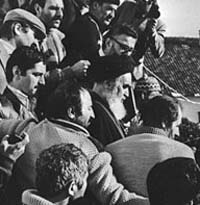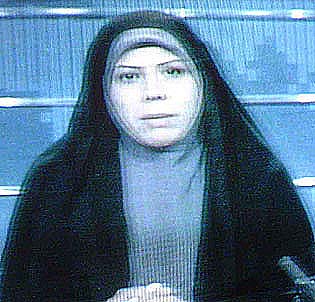
Ayatollah Ruhollah Khomeini, surrounded by journalists in January 1979, just after hearing the news that the Shah has left Iran Photo: Keystone/Getty Images |
From the mid 1970s onward, the authoritarian Pahlavi regime began to show signs of weakness. Facing increasing pressure from human rights organizations such as P.E.N. International, Amnesty International, and the International Commission of Jurists, as well as the new administration of Jimmy Carter, the Shah began to relax some longstanding restrictions on freedoms of expression and association. A selected number of political prisoners were released, political parties gradually began to organize once again, and the press began to take chances on what it would publish. In the summer of 1977 a series of “open letters to the Shah” were published in a number of important Iranian dailies. These open letters, criticizing the lack of political freedom in Iran, were signed by leading intellectuals, prominent lawyers, and political veterans of the Mosaddeq era. After almost twenty-five years of official control of the media the publication of these open letters represented a major test of the Shah’s overtures towards liberalization.
Even more important than the open letters published by the secular-liberal wing of the opposition was the flurry of printed materials and other forms of media that began to circulate from the religious opposition. The secular and religious opposition movements had maintained an uneasy collaborative relationship since the constitutional period, but as early as 1965 the political opposition to the Shah had begun to take on increasingly religious characteristics overall.
Exiled from Iran for his public denunciations of the Shah’s policies in the early 1960s the Ayatollah Khomeini increasingly became the figurehead of this religious opposition. With the new liberalization that took place beginning in 1977, Khomeini’s supporters began to publicize his political pronouncements. From official exile — first in Najaf, Iraq and then in Paris — Khomeini, with the help of a large network of revolutionary students both within and outside of Iran, began to circulate his sermons on audiocassette. These audiocassettes, calling for the overthrow of the monarchy, became the main form of revolutionary communication between the revolutionary religious leadership outside of Iran and the growing religious opposition movement inside the country. From the late fall of 1977 to the final overthrow of the monarchy on February 11th, 1979, it was the underground media — the galvanizing force of sermons delivered via audiocassette, along with hand-pressed leaflets, impromptu revolutionary communiqués, the ad-hoc alternative press, and radical graffiti written on the walls of the major cities — that became the basis of the mass movement that overthrew the monarchy. Once again, as had been the case during the Constitutional period, the media (in both official and underground forms) came to play a central role in building popular support for radical change in Iranian political life.
In the years since the revolution, moments of free expression and a liberalized popular press have alternated with periods of state-imposed control, censorship, and even the shuttering of publications and the imprisonment of journalists — maintaining the dynamic between press and politicians that has characterized modern Iranian history.

A female television weather reporter, on official Islamic Republic Television, in July 2004 Photo: Afshin Marashi |
In the immediate aftermath of the revolution, the conservative religious forces — as part of their move to consolidate power to the exclusion of the secular liberal groups who had participated in the revolution — made a concerted effort to impose a new official line on the press and media. The former Ministry of Information, which had under the Shah been the main body controlling the press, was now renamed the Ministry of Culture and Islamic Guidance; its role remained essentially the same, however: to censor the media and enforce the ideological line of the government. Many of the major dailies were sold or expropriated by the revolutionary courts and turned into organs of the official Islamist position. The important newspapers Ettela’at and Kayhan were in this way turned into outlets for the political views of the revolutionary government. Radio and television were similarly subordinated to revolutionary ideology, with programming devoted to a concerted policy of Islamizing Iranian society.
It is against this backdrop that the current relationship between media and politics in Iranian society should be understood. With the election of President Muhammad Khatami in 1997, politics in Iran entered a new phase — at least for the revolutionary period — in which Iranians once again demanded democracy and basic freedoms. These periodic calls for democratic reform, including the demand for the freedom of the press, have been central to Iranian politics since the beginning of its modern history. What followed was a liberalization of the mainstream press, with the launch of hundreds of periodicals associated with the reform movement. These papers have maintained an uneasy truce with the clerical establishment, and have suffered a number of crackdowns. With the conservative reconsolidation of power following the 2004 parliamentary elections as well as the election of conservative president Mahmoud Ahmadinejad in 2005, the future of the reformist press is uncertain, but several high-profile papers — like Shargh — continue to publish.
There are other alternatives — today’s communication technology allows for an underground press that goes well beyond hand-pressed revolutionary newspapers smuggled in from abroad, or audiocassettes circulating clandestinely in the bazaars and mosques of the major cities. Today’s democratic opposition movement has made extensive use of the Internet (with particular focus on an extensive network of bloggers) and satellite television, which flourishes despite an official ban on the possession of dishes. A new generation of Iranian journalists are producing newspapers and periodicals that are asking brave questions, challenging the authority of the state, and working once again to bring voices of dissent into the public sphere.
- Previous: Under the Pahlavis


